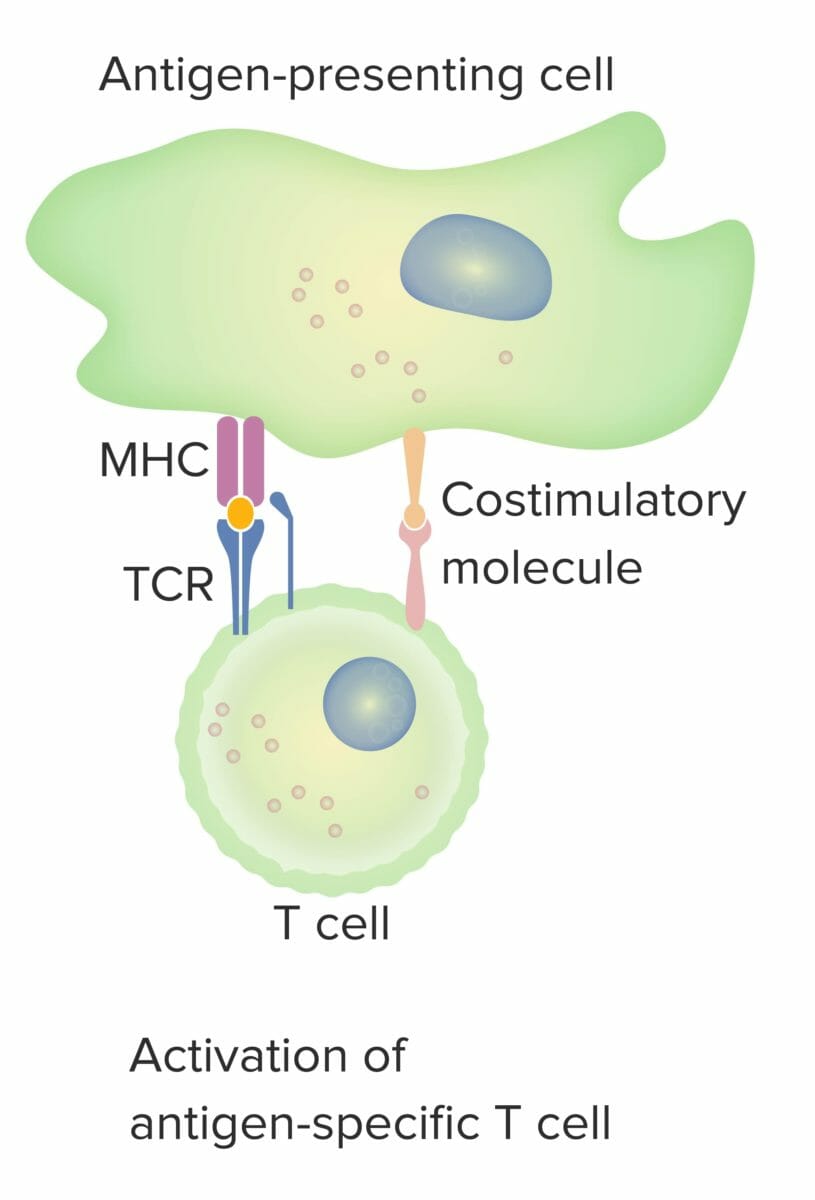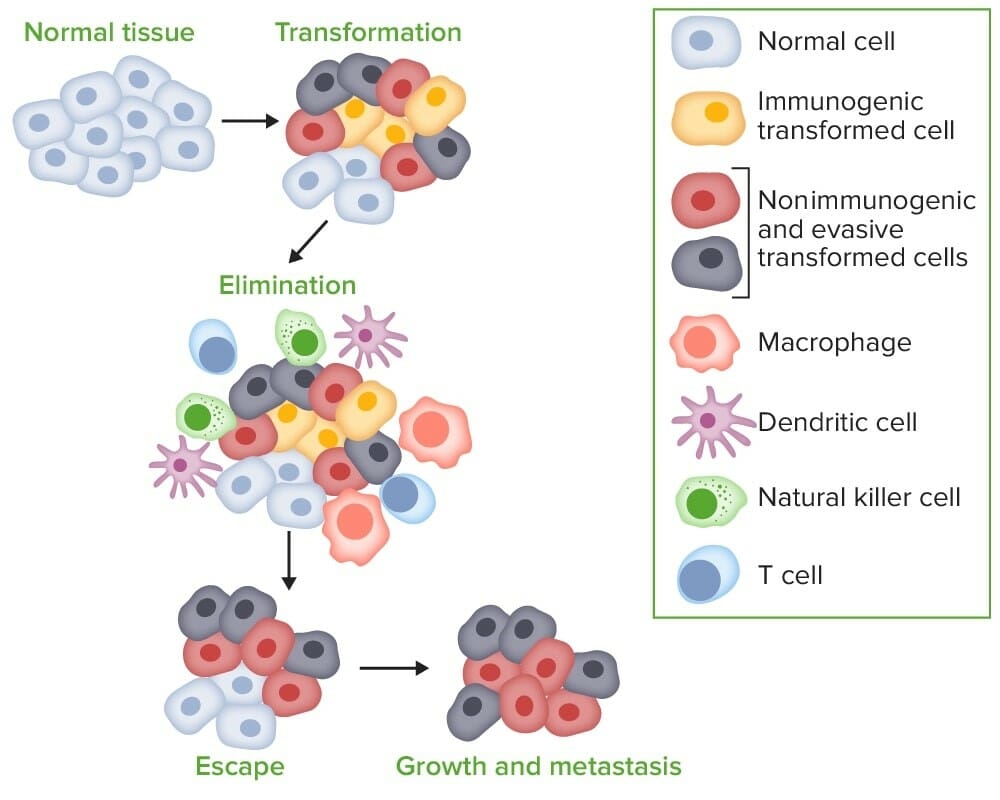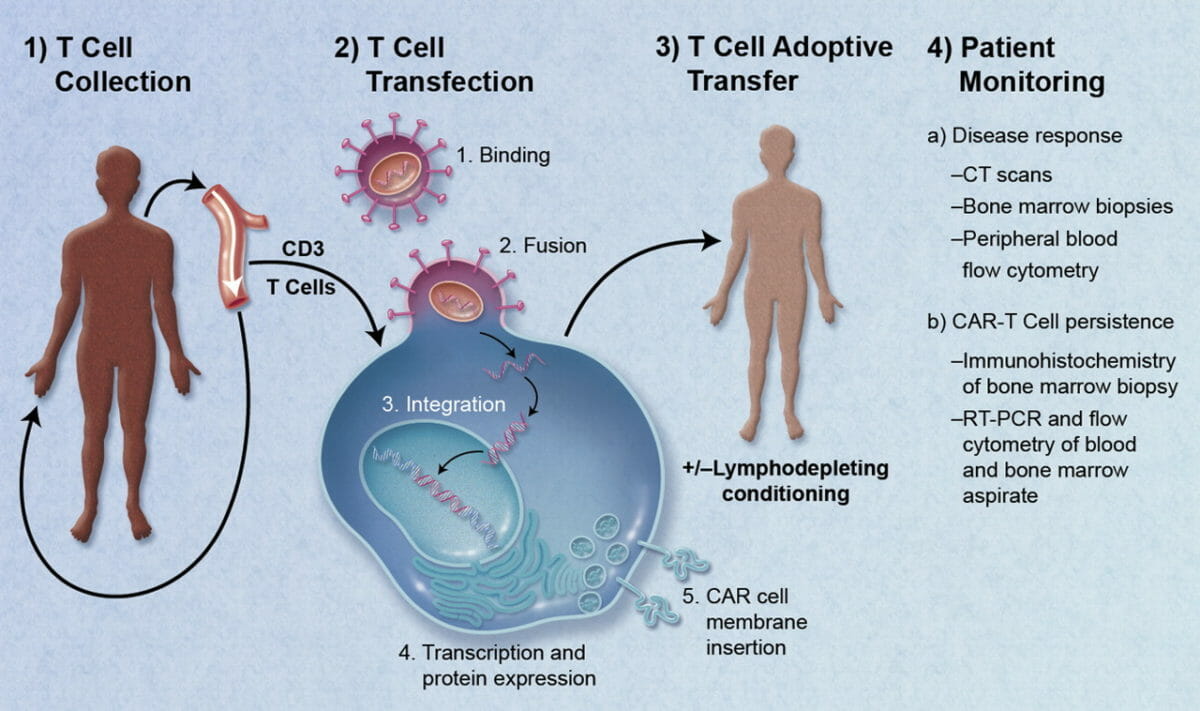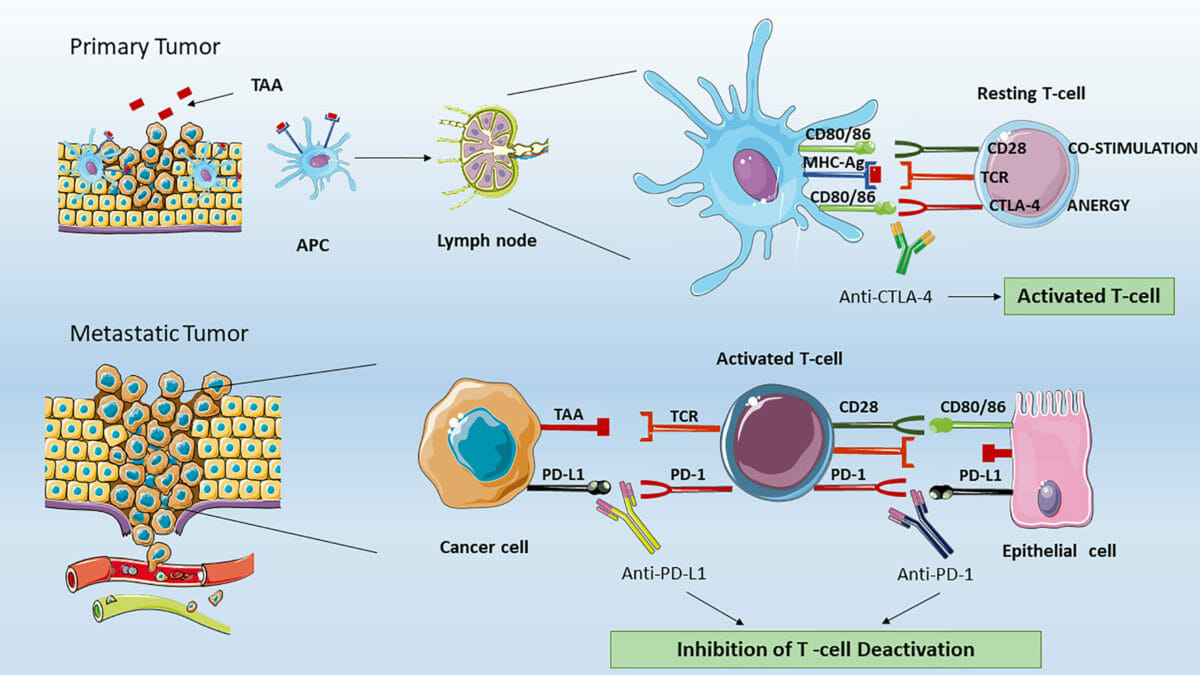Cancer immunotherapy is a rapidly advancing medical therapy that takes advantage of the immune system Immune system The body's defense mechanism against foreign organisms or substances and deviant native cells. It includes the humoral immune response and the cell-mediated response and consists of a complex of interrelated cellular, molecular, and genetic components. Primary Lymphatic Organs to contain or eliminate cancer cells. Currently, immunotherapies have been incorporated into treatment regimens for different types of cancer. Various therapeutic approaches exist, including using cytokines Cytokines Non-antibody proteins secreted by inflammatory leukocytes and some non-leukocytic cells, that act as intercellular mediators. They differ from classical hormones in that they are produced by a number of tissue or cell types rather than by specialized glands. They generally act locally in a paracrine or autocrine rather than endocrine manner. Adaptive Immune Response, vaccines, oncolytic viruses Viruses Minute infectious agents whose genomes are composed of DNA or RNA, but not both. They are characterized by a lack of independent metabolism and the inability to replicate outside living host cells. Virology, T-cell manipulation or cellular adoptive immunotherapy, or antibodies Antibodies Immunoglobulins (Igs), also known as antibodies, are glycoprotein molecules produced by plasma cells that act in immune responses by recognizing and binding particular antigens. The various Ig classes are IgG (the most abundant), IgM, IgE, IgD, and IgA, which differ in their biologic features, structure, target specificity, and distribution. Immunoglobulins: Types and Functions to immune checkpoint molecules. These therapies provide new options for advanced cancers, including melanoma Melanoma Melanoma is a malignant tumor arising from melanocytes, the melanin-producing cells of the epidermis. These tumors are most common in fair-skinned individuals with a history of excessive sun exposure and sunburns. Melanoma, renal cell carcinoma Renal cell carcinoma Renal cell carcinoma (RCC) is a tumor that arises from the lining of the renal tubular system within the renal cortex. Renal cell carcinoma is responsible for 80%-85% of all primary renal neoplasms. Most RCCs arise sporadically, but smoking, hypertension, and obesity are linked to its development. Renal Cell Carcinoma, prostate Prostate The prostate is a gland in the male reproductive system. The gland surrounds the bladder neck and a portion of the urethra. The prostate is an exocrine gland that produces a weakly acidic secretion, which accounts for roughly 20% of the seminal fluid. adenocarcinoma, lung cancer Lung cancer Lung cancer is the malignant transformation of lung tissue and the leading cause of cancer-related deaths. The majority of cases are associated with long-term smoking. The disease is generally classified histologically as either small cell lung cancer or non-small cell lung cancer. Symptoms include cough, dyspnea, weight loss, and chest discomfort. Lung Cancer, urothelial carcinoma, Hodgkin lymphoma Lymphoma A general term for various neoplastic diseases of the lymphoid tissue. Imaging of the Mediastinum, and refractory B-cell ALL. With the immune system Immune system The body's defense mechanism against foreign organisms or substances and deviant native cells. It includes the humoral immune response and the cell-mediated response and consists of a complex of interrelated cellular, molecular, and genetic components. Primary Lymphatic Organs involved, these agents carry serious and potentially fulminant adverse effects and toxicities.
Last updated: Dec 15, 2025
The immune system Immune system The body’s defense mechanism against foreign organisms or substances and deviant native cells. It includes the humoral immune response and the cell-mediated response and consists of a complex of interrelated cellular, molecular, and genetic components. Primary Lymphatic Organs provides defense (immunity) against invading pathogens ranging from viruses Viruses Minute infectious agents whose genomes are composed of DNA or RNA, but not both. They are characterized by a lack of independent metabolism and the inability to replicate outside living host cells. Virology to parasites, and components are interconnected by blood and the lymphatic circulation Circulation The movement of the blood as it is pumped through the cardiovascular system. ABCDE Assessment.
The 2 lines of defense Lines of Defense Inflammation (that overlap):
Over 20,000 DNA-damaging events occur each day, which undergo repair via specific pathways, thus causing no lasting effect.

The 2-signal model of T-cell dependence on costimulation:
When both signal 1 (T-cell receptor (TCR) binding the cognate antigen presented by the MHC molecule in the antigen-presenting cell) and signal 2 (costimulatory molecule interaction between the antigen-presenting cell and the T cell) are present, the mature T cell is fully activated.
The orange spot indicates proper binding between antigen and TCR.
Immunoediting is a process consisting of immunologic tumor Tumor Inflammation suppression Suppression Defense Mechanisms but can lead to tumor Tumor Inflammation progression. Immunoediting occurs in 3 main phases:

Carcinogenesis by immune evasion:
When tumor cells transform from normal cells, the innate and adaptive immune systems detect and eliminate the transformed cells even before disease is clinically apparent (elimination). The process enters equilibrium, as tumor-cell variants may not be completely eliminated. However, the immune system attempts to control tumor-cell outgrowth by exerting selective pressure on highly immunogenic tumor cells. Tumor-cell immunogenicity is edited, leaving cells with reduced immunogenicity to grow and evade immunosurveillance, leading to progression of the cells into the escape phase, where the less immunogenic cells grow progressively and become clinically apparent cancer.
Cancer immunotherapy stimulates the immune system Immune system The body’s defense mechanism against foreign organisms or substances and deviant native cells. It includes the humoral immune response and the cell-mediated response and consists of a complex of interrelated cellular, molecular, and genetic components. Primary Lymphatic Organs to respond to a malignancy Malignancy Hemothorax, activating different aspects of the immune system Immune system The body’s defense mechanism against foreign organisms or substances and deviant native cells. It includes the humoral immune response and the cell-mediated response and consists of a complex of interrelated cellular, molecular, and genetic components. Primary Lymphatic Organs to attack cancer cells.
These therapies are developed based on the manipulation of the individual’s cells through in vitro expansion of tumor-specific T cells T cells Lymphocytes responsible for cell-mediated immunity. Two types have been identified – cytotoxic (t-lymphocytes, cytotoxic) and helper T-lymphocytes (t-lymphocytes, helper-inducer). They are formed when lymphocytes circulate through the thymus gland and differentiate to thymocytes. When exposed to an antigen, they divide rapidly and produce large numbers of new T cells sensitized to that antigen. T cells: Types and Functions, which are reinfused by autologous transplantation.
Techniques of manipulating T cells T cells Lymphocytes responsible for cell-mediated immunity. Two types have been identified – cytotoxic (t-lymphocytes, cytotoxic) and helper T-lymphocytes (t-lymphocytes, helper-inducer). They are formed when lymphocytes circulate through the thymus gland and differentiate to thymocytes. When exposed to an antigen, they divide rapidly and produce large numbers of new T cells sensitized to that antigen. T cells: Types and Functions (and other immune cell types):

Cellular adaptive immunotherapy:
1) T cells are collected.
2) The T cells are engineered to express chimeric antigen receptors (CARs), followed by in vitro expansion.
3) These cells are then infused into the same individual. These cells go into circulation, recognizing and destroying malignant cells.
4) Subsequent monitoring of disease response follows.

Immune checkpoint inhibitors:
Top: Antigen-presenting cells process tumor-associated antigens (TAAs) and complex them to MHC molecules.
The antigen-presenting cells migrate to the lymph node (in T-cell–dominant areas) and present TAAs to the naive T cells.
Activation of the T cell requires 2 signals. The 1st is mediated by the binding of TAA to a T-cell receptor (TCR). The 2nd signal can be from the binding of T-cell CD28 to costimulatory CD80/CD86, which activates the T cell.
However, when the T-cell-CTLA-4 interacts with the same CD80/CD86 antigen-presenting–cell molecules, the effect is inhibitory (T-cell anergy or no T-cell activation occurs).
Therefore, CTLA-4 and CD28 compete for the binding to CD80/CD86 proteins. The anti-CTLA-4 blocking action of ipilimumab restores CD28 proactivator signaling, resulting in antitumor T-lymphocyte responses.
Bottom: In peripheral tissues, the activated T cell can be deactivated by the binding of T-cell programmed death cell-1 (PD-1) with programmed cell death ligand 1 (PD-L1) (or PD-L2) expressed on tumor cells. The anti-PD-1 or anti–PD-L1 blocking action by monoclonal antibodies (e.g., nivolumab, pembrolizumab, atezolizumab) restores effective antitumor T-lymphocyte activity.
| Therapeutic class | Agents | Indications |
|---|---|---|
| Immunostimulatory cytokines Cytokines Non-antibody proteins secreted by inflammatory leukocytes and some non-leukocytic cells, that act as intercellular mediators. They differ from classical hormones in that they are produced by a number of tissue or cell types rather than by specialized glands. They generally act locally in a paracrine or autocrine rather than endocrine manner. Adaptive Immune Response | IL–2 |
|
| IFNα-2b |
|
|
| Vaccines | Sipuleucel-T | Castration-resistant prostate Prostate The prostate is a gland in the male reproductive system. The gland surrounds the bladder neck and a portion of the urethra. The prostate is an exocrine gland that produces a weakly acidic secretion, which accounts for roughly 20% of the seminal fluid. adenocarcinoma |
| Bacille Calmette–Guérin (BCG) | Bladder Bladder A musculomembranous sac along the urinary tract. Urine flows from the kidneys into the bladder via the ureters, and is held there until urination. Pyelonephritis and Perinephric Abscess cancer | |
| Immunomodulatory agents |
|
Multiple myeloma Multiple myeloma Multiple myeloma (MM) is a malignant condition of plasma cells (activated B lymphocytes) primarily seen in the elderly. Monoclonal proliferation of plasma cells results in cytokine-driven osteoclastic activity and excessive secretion of IgG antibodies. Multiple Myeloma |
| Oncolytic viruses Viruses Minute infectious agents whose genomes are composed of DNA or RNA, but not both. They are characterized by a lack of independent metabolism and the inability to replicate outside living host cells. Virology | T-VEC | Melanoma Melanoma Melanoma is a malignant tumor arising from melanocytes, the melanin-producing cells of the epidermis. These tumors are most common in fair-skinned individuals with a history of excessive sun exposure and sunburns. Melanoma |
| CAR T-cell therapy | Agents are available under the REMS program of the FDA (for autologous use only). |
|
| BiTE (CD3-directed therapy) | Blinatumomab | ALL |
| Therapeutic class | Agents | Indications |
|---|---|---|
| Anti-PD-1 | Pembrolizumab Pembrolizumab Squamous Cell Carcinoma (SCC) |
|
| Nivolumab Nivolumab A genetically engineered, fully humanized immunoglobulin g4 monoclonal antibody that binds to the pd-1 receptor, activating an immune response to tumor cells. It is used as monotherapy or in combination with ipilimumab for the treatment of advanced malignant melanoma. It is also used in the treatment of advanced or recurring non-small cell lung cancer; renal cell carcinoma; and Hodgkin’s lymphoma. Melanoma |
|
|
| Dostarlimab |
|
|
| Anti-PD-L1 | Atezolizumab |
|
| Avelumab |
|
|
| Durvalumab |
|
|
| Anti–CTLA-4 | Ipilimumab |
|